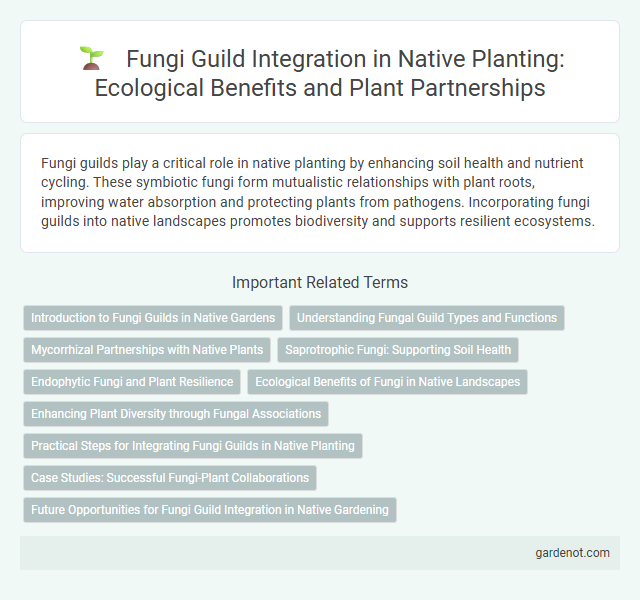Fungi guilds play a critical role in native planting by enhancing soil health and nutrient cycling. These symbiotic fungi form mutualistic relationships with plant roots, improving water absorption and protecting plants from pathogens. Incorporating fungi guilds into native landscapes promotes biodiversity and supports resilient ecosystems.
Introduction to Fungi Guilds in Native Gardens
Fungi guilds play a crucial role in native gardens by forming symbiotic relationships with plants, enhancing nutrient uptake and soil health. These fungal communities, including mycorrhizal fungi, decompose organic matter and improve water retention, supporting native plant resilience and growth. Integrating fungi guilds in native planting promotes biodiversity and creates sustainable ecosystems that mimic natural processes.
Understanding Fungal Guild Types and Functions
Fungal guilds consist of groups of fungi classified by their ecological roles such as decomposers, mutualists, and pathogens, each playing a critical role in native planting ecosystems. Mycorrhizal fungi form symbiotic relationships with plant roots, enhancing nutrient uptake and soil health, while saprotrophic fungi decompose organic matter, enriching soil fertility. Pathogenic fungi regulate plant populations by controlling disease dynamics, maintaining ecological balance within native plant communities.
Mycorrhizal Partnerships with Native Plants
Mycorrhizal partnerships form symbiotic associations between native plants and fungi, enhancing nutrient uptake and soil health. These fungi penetrate plant roots, increasing access to water and essential minerals like phosphorus and nitrogen. Native ecosystems thrive through these fungi guilds, promoting biodiversity and ecosystem resilience.
Saprotrophic Fungi: Supporting Soil Health
Saprotrophic fungi play a vital role in native planting by breaking down organic matter, releasing essential nutrients into the soil and enhancing nutrient cycling. These fungi decompose leaf litter, wood debris, and other organic materials, improving soil structure and promoting microbial diversity. Their activity supports soil health and fertility, facilitating robust plant growth in natural ecosystems.
Endophytic Fungi and Plant Resilience
Endophytic fungi form symbiotic relationships within native plants, enhancing their resilience by improving nutrient uptake and stress tolerance. These fungi produce bioactive compounds that help plants resist pathogens and environmental stressors such as drought or soil contamination. Integrating endophytic fungi into native planting promotes ecosystem stability and supports sustainable restoration efforts.
Ecological Benefits of Fungi in Native Landscapes
Fungi guilds in native planting systems play a crucial role in enhancing soil health, nutrient cycling, and plant resilience by forming symbiotic relationships with native vegetation. Mycorrhizal fungi, a key component of these guilds, increase water and nutrient uptake, improving plant growth and stress tolerance in native landscapes. Their ecological functions contribute to biodiversity, soil structure improvement, and ecosystem stability, making them vital for sustainable native habitat restoration and management.
Enhancing Plant Diversity through Fungal Associations
Fungi guilds play a critical role in enhancing plant diversity by forming mutualistic associations with native plants, improving nutrient availability and soil health. These fungal networks facilitate nutrient exchange, increase plant resilience to environmental stress, and promote the establishment of diverse plant communities. Incorporating fungi guilds in native planting strategies supports ecosystem stability and biodiversity conservation.
Practical Steps for Integrating Fungi Guilds in Native Planting
Incorporating fungi guilds into native planting enhances soil health, nutrient cycling, and plant resilience. Start by selecting native mycorrhizal fungi compatible with local plant species to improve root absorption and establish symbiotic relationships. Apply fungal inoculants during planting to boost early colonization and maintain soil moisture to support fungal growth and ecosystem balance.
Case Studies: Successful Fungi-Plant Collaborations
Fungi guilds play a critical role in native planting by enhancing nutrient cycling and improving plant health through symbiotic relationships. Case studies highlight successful fungi-plant collaborations, such as mycorrhizal fungi increasing water uptake and disease resistance in native grasses and trees. Research demonstrates that integrating specific fungi species into restoration projects accelerates ecosystem recovery and boosts biodiversity.
Future Opportunities for Fungi Guild Integration in Native Gardening
Fungi guild integration in native gardening presents future opportunities to enhance soil health by improving nutrient cycling and moisture retention through symbiotic mycorrhizal networks. Native fungi species can support plant resilience against pests and environmental stressors, promoting sustainable ecosystem balance. Expanding research on region-specific fungal partnerships will optimize native plant growth and biodiversity restoration efforts.
Fungi guild Infographic

 gardenot.com
gardenot.com